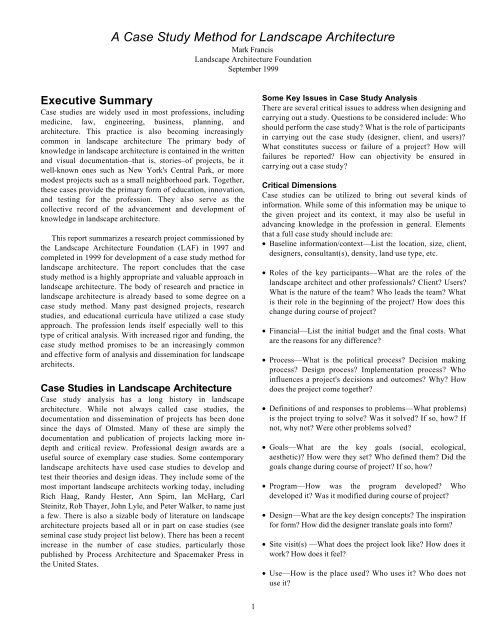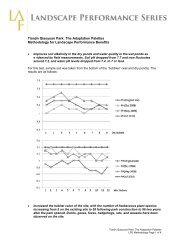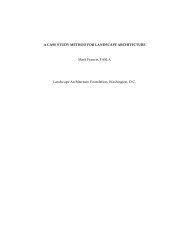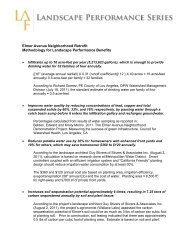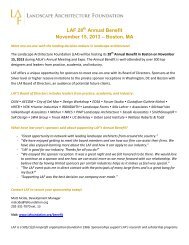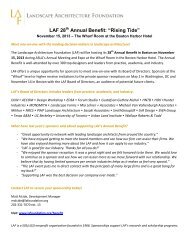A Case Study Method Abstract - Landscape Architecture Foundation
A Case Study Method Abstract - Landscape Architecture Foundation
A Case Study Method Abstract - Landscape Architecture Foundation
You also want an ePaper? Increase the reach of your titles
YUMPU automatically turns print PDFs into web optimized ePapers that Google loves.
A <strong>Case</strong> <strong>Study</strong> <strong>Method</strong> for <strong>Landscape</strong> <strong>Architecture</strong><br />
Mark Francis<br />
<strong>Landscape</strong> <strong>Architecture</strong> <strong>Foundation</strong><br />
September 1999<br />
Executive Summary<br />
<strong>Case</strong> studies are widely used in most professions, including<br />
medicine, law, engineering, business, planning, and<br />
architecture. This practice is also becoming increasingly<br />
common in landscape architecture The primary body of<br />
knowledge in landscape architecture is contained in the written<br />
and visual documentation–that is, stories–of projects, be it<br />
well-known ones such as New York's Central Park, or more<br />
modest projects such as a small neighborhood park. Together,<br />
these cases provide the primary form of education, innovation,<br />
and testing for the profession. They also serve as the<br />
collective record of the advancement and development of<br />
knowledge in landscape architecture.<br />
This report summarizes a research project commissioned by<br />
the <strong>Landscape</strong> <strong>Architecture</strong> <strong>Foundation</strong> (LAF) in 1997 and<br />
completed in 1999 for development of a case study method for<br />
landscape architecture. The report concludes that the case<br />
study method is a highly appropriate and valuable approach in<br />
landscape architecture. The body of research and practice in<br />
landscape architecture is already based to some degree on a<br />
case study method. Many past designed projects, research<br />
studies, and educational curricula have utilized a case study<br />
approach. The profession lends itself especially well to this<br />
type of critical analysis. With increased rigor and funding, the<br />
case study method promises to be an increasingly common<br />
and effective form of analysis and dissemination for landscape<br />
architects.<br />
<strong>Case</strong> Studies in <strong>Landscape</strong> <strong>Architecture</strong><br />
<strong>Case</strong> study analysis has a long history in landscape<br />
architecture. While not always called case studies, the<br />
documentation and dissemination of projects has been done<br />
since the days of Olmsted. Many of these are simply the<br />
documentation and publication of projects lacking more indepth<br />
and critical review. Professional design awards are a<br />
useful source of exemplary case studies. Some contemporary<br />
landscape architects have used case studies to develop and<br />
test their theories and design ideas. They include some of the<br />
most important landscape architects working today, including<br />
Rich Haag, Randy Hester, Ann Spirn, Ian McHarg, Carl<br />
Steinitz, Rob Thayer, John Lyle, and Peter Walker, to name just<br />
a few. There is also a sizable body of literature on landscape<br />
architecture projects based all or in part on case studies (see<br />
seminal case study project list below). There has been a recent<br />
increase in the number of case studies, particularly those<br />
published by Process <strong>Architecture</strong> and Spacemaker Press in<br />
the United States.<br />
Some Key Issues in <strong>Case</strong> <strong>Study</strong> Analysis<br />
There are several critical issues to address when designing and<br />
carrying out a study. Questions to be considered include: Who<br />
should perform the case study? What is the role of participants<br />
in carrying out the case study (designer, client, and users)?<br />
What constitutes success or failure of a project? How will<br />
failures be reported? How can objectivity be ensured in<br />
carrying out a case study?<br />
Critical Dimensions<br />
<strong>Case</strong> studies can be utilized to bring out several kinds of<br />
information. While some of this information may be unique to<br />
the given project and its context, it may also be useful in<br />
advancing knowledge in the profession in general. Elements<br />
that a full case study should include are:<br />
• Baseline information/context—List the location, size, client,<br />
designers, consultant(s), density, land use type, etc.<br />
• Roles of the key participants—What are the roles of the<br />
landscape architect and other professionals? Client? Users?<br />
What is the nature of the team? Who leads the team? What<br />
is their role in the beginning of the project? How does this<br />
change during course of project?<br />
• Financial—List the initial budget and the final costs. What<br />
are the reasons for any difference?<br />
• Process—What is the political process? Decision making<br />
process? Design process? Implementation process? Who<br />
influences a project's decisions and outcomes? Why? How<br />
does the project come together?<br />
• Definitions of and responses to problems—What problems)<br />
is the project trying to solve? Was it solved? If so, how? If<br />
not, why not? Were other problems solved?<br />
• Goals—What are the key goals (social, ecological,<br />
aesthetic)? How were they set? Who defined them? Did the<br />
goals change during course of project? If so, how?<br />
• Program—How was the program developed? Who<br />
developed it? Was it modified during course of project?<br />
• Design—What are the key design concepts? The inspiration<br />
for form? How did the designer translate goals into form?<br />
• Site visit(s) —What does the project look like? How does it<br />
work? How does it feel?<br />
• Use—How is the place used? Who uses it? Who does not<br />
use it?<br />
1
• Maintenance and management—What are the problems of<br />
management and maintenance? What are the maintenance<br />
costs? How is the project perceived by space managers?<br />
• Perception and meaning—Describe how the place is<br />
perceived and valued.<br />
• Scale—What is the size of the project? Dimensions of key<br />
elements? Amount of site coverage and impervious surface?<br />
• Time—How well does the place fare over time? How does<br />
project age incrementally?<br />
• Unique constraints—How were they addressed in process?<br />
• Community—How is the community served by this project?<br />
What is its social impact? Meaning?<br />
• Environmental sensitivity and impact—How is the<br />
environment served by this project? What is its contribution<br />
to sustainability?<br />
• Impact on profession—How is the profession served by this<br />
project? What does it contribute to the professional<br />
knowledge base?<br />
• Infrastructure—What are the underlying challenges of the<br />
site? Technological constraints?<br />
• Lessons learned—Describe the site-specific lessons learned<br />
in comparison to the more generalizable lessons?<br />
• Theoretical underpinning—Why was the project done?<br />
What are the questions it is trying to answer? Problem(s) it<br />
is trying to solve?<br />
• Outside critiques—Include critiques by awards jury, experts,<br />
users, review committees, design critics, and journalists. Has<br />
there been any controversy associated with the project? Has<br />
this been resolved? If so, how?<br />
A Suggested Format for <strong>Case</strong> Studies<br />
From the range of knowledge that can make up a case study, at<br />
least three levels of information are possible in a case study<br />
analysis. The first, and simplest, is a project abstract (2 to 3<br />
pages). The second is a full project case study. The third is a<br />
more in-depth case study with contextual or specialized<br />
material included. While each may have a different audience,<br />
the greatest need, especially in teaching, is for the more<br />
detailed case studies of the second and third level.<br />
Full case study<br />
• project name<br />
• location<br />
• date designed/planned<br />
• construction completed<br />
• cost<br />
• size<br />
• landscape architects<br />
• client<br />
• consultants<br />
• managed by<br />
• context<br />
• site analysis<br />
• project background and history<br />
• genesis of project<br />
• design, development, and decision making processes<br />
• role of landscape architects<br />
• program elements<br />
• maintenance and management<br />
• photographs)<br />
• site plants)<br />
• user /use analysis<br />
• peer reviews<br />
• criticism<br />
• significance and uniqueness of project<br />
• limitations<br />
• generalizable features and lessons<br />
• future issues /plans<br />
• bibliography of project citations/references<br />
• Web sites /links<br />
• contacts for further information<br />
In-depth analysis<br />
There are often more in-depth and case specific considerations<br />
unique to this type of case study. They may include:<br />
• archival research (project records, newspaper articles, etc.)<br />
• awards or special recognition for project<br />
• copies of articles or reports on project<br />
• interviews with client<br />
• interviews with managers and maintenance people<br />
• interviews with users<br />
• interviews with non-users<br />
• longitudinal studies of the place over time<br />
<strong>Abstract</strong>/fact sheet<br />
• photo(s)<br />
• project background<br />
• project significance and impact<br />
• lessons learned<br />
• contacts<br />
• keywords<br />
2


